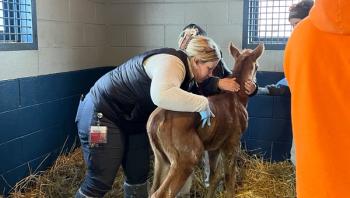
AVMA clarifies report's context on lethal injection
Schaumburg, Ill. ? The American Veterinary Medical Association (AVMA) wants capital punishment opponents to stop quoting its euthanasia guidelines to contest lethal injection.
SCHAUMBURG, ILL. — The American Veterinary Medical Association (AVMA) wants capital punishment opponents to stop quoting its euthanasia guidelines to contest lethal injection.
At presstime, the group approved a landing letter highlighting "misinterpretations" to its 2000 Report of the AVMA Panel on Euthanasia, which has bolstered death penalty appeals from Kentucky to Texas. Capital punishment opponents use the guidelines as a legal tactic to challenge use of pancuronium bromide, one ingredient in the three-drug cocktail of most lethal injections. AVMA deems the muscle relaxant so cruel, the group advises against using it on animals, prisoner advocates say, adding that a slight dosage error could cause inmates to suffocate before losing consciousness and paralyze them while dying.
For the record
But AVMA's stance on the drug has been misinterpreted, group leaders say. The group's 27-page euthanasia report fails to mention pancuronium bromide, which paralyzes skeletal muscles but not the brain or nerves. Under the heading "pentobarbital combinations," AVMA notes, "A combination of pentobarbital with a neuromuscular blocking agent is not an acceptable euthanasia agent."
Capital punishment opponents and the media have wrongly used this statement and others to infer that AVMA deems the drug's use for euthanasia inhumane, says Dr. Elizabeth Sabin, assistant director of the AVMA Education and Research Division.
"The panel's objective in developing these guidelines was to give veterinarians guidance in relieving pain and suffering of animals that are to be euthanized," she says. "The report should not be extrapolated to humans."
Line by line
To further clarify the guidelines, AVMA outlines the report's segments that have been misinterpreted most:
1. Agents that induce death by direct or indirect hypoxia can act at various sites and can cause loss of consciousness at different rates. For death to be painless and distress-free, loss of consciousness should precede loss of motor activity. Loss of motor activity, however, cannot be equated with loss of consciousness and absence of distress. Thus, agents that induce muscle paralysis without loss of consciousness are not acceptable as sole agents for euthanasia (e.g., depolarizing and non-depolarizing muscle relaxants, strychnine, nicotine and magnesium slats). With other techniques that induce hypoxia, some animals may have motor activity following loss of consciousness, but this is reflex activity and is not perceived by the animal.
2. Pentobarbital combinations: Several euthanasia products are formulated to include a barbituric acid derivative, usually sodium pentobarbital. Although some of these additives are slowly cardio toxic, this pharmacologic effect is inconsequential. These combination products are listed by the (Drug Enforcement Agency) as Schedule III drugs, making them somewhat simpler to obtain, store and administer than Schedule II drugs such as sodium pentobarbital. The pharmacologic properties and recommended use of combination products that combine sodium pentobarbital with lidocaine or phenytoin are interchangeable with those of pure barbituric acid derivatives.
The first section of text indicates that neuromuscular blocking agents should not be the sole method of euthanasia. The second section refers to mixing a barbiturate and neuromuscular blocking agent in the same syringe, which might allow the animal to become paralyzed while conscious. Both actions do not happen during human lethal injections, AVMA says.
"When referring to the 2000 Report of the AVMA Panel on Euthanasia, reporters are strongly encouraged to contact the AVMA to ensure the association's position is stated correctly," AVMA officials add.
Newsletter
From exam room tips to practice management insights, get trusted veterinary news delivered straight to your inbox—subscribe to dvm360.






